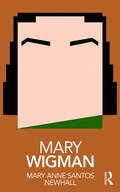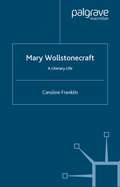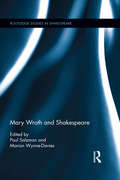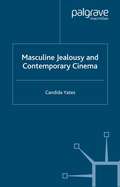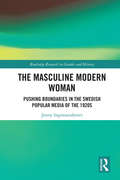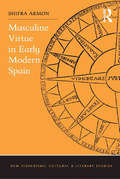- Table View
- List View
Mary Wigman: Modernity And Mary Wigman, 1886--1973 (Routledge Performance Practitioners)
by Mary Anne Santos NewhallThis book considers dancer, teacher, and choreographer Mary Wigman, a leading innovator in Expressionist dance whose radical explorations of movement and dance theory are credited with expanding the scope of dance as a theatrical art. Now reissued, this book combines: a full account of Wigman’s life and work an analysis of her key ideas detailed discussion of her aesthetic theories, including the use of space as an "invisible partner" and the transcendent nature of performance a commentary on her key works, including Hexentanz and The Seven Dances of Life an extensive collection of practical exercises designed to provide an understanding of Wigman’s choreographic principles and her uniquely immersive approach to dance. As a first step towards critical understanding, and as an initial exploration before going on to further, primary research, Routledge Performance Practitioners are unbeatable value for today’s student.
Mary Wollstonecraft: A Literary Life (Literary Lives)
by C. FranklinThis study argues that protestant society had traditionally sanctioned women's role in spreading literacy, but this became politicized in the 1790s. Wollstonecraft's literary vocation was shaped by the expectations of the power of print to educate and reform individuals and society, in the radical circles of the Unitarian publisher Joseph Johnson.
Mary Wollstonecraft and Feminist Republicanism: Independence, Rights and the Experience of Unfreedom (The Enlightenment World)
by Lena HalldeniusMary Wollstonecraft is a writer whose work continues to provoke scholarly debate. Halldenius explores Wollstonecraft’s political philosophy, focusing on her treatment of republicanism and independence, to propose a new way of reading her work – that of a ‘feminist republican’.
Mary Wollstonecraft and Feminist Republicanism: Independence, Rights and the Experience of Unfreedom (The Enlightenment World #30)
by Lena HalldeniusMary Wollstonecraft is a writer whose work continues to provoke scholarly debate. Halldenius explores Wollstonecraft’s political philosophy, focusing on her treatment of republicanism and independence, to propose a new way of reading her work – that of a ‘feminist republican’.
Mary Wroth and Shakespeare (Routledge Studies in Shakespeare)
by Paul Salzman Marion Wynne-DaviesOver the last twenty five years, scholarship on Early Modern women writers has produced editions and criticisms, both on various groups and individual authors. The work on Mary Wroth has been particularly impressive at integrating her poetry, prose and drama into the canon. This in turn has led to comparative studies that link Wroth to a number of male and female writers, including of course, William Shakespeare. At the same time no single volume has attempted a comprehensive comparative analysis. This book sets out to explore the ways in which Wroth negotiated the discourses that are embedded in the Shakespearean canon in order to develop an understanding of her oeuvre based, not on influence and imitation, but on difference, originality and innovation.
Mary Wroth and Shakespeare (Routledge Studies in Shakespeare)
by Paul Salzman Marion Wynne-DaviesOver the last twenty five years, scholarship on Early Modern women writers has produced editions and criticisms, both on various groups and individual authors. The work on Mary Wroth has been particularly impressive at integrating her poetry, prose and drama into the canon. This in turn has led to comparative studies that link Wroth to a number of male and female writers, including of course, William Shakespeare. At the same time no single volume has attempted a comprehensive comparative analysis. This book sets out to explore the ways in which Wroth negotiated the discourses that are embedded in the Shakespearean canon in order to develop an understanding of her oeuvre based, not on influence and imitation, but on difference, originality and innovation.
Marye's Heights: Fredericksburg (Battleground America Ser.)
by Victor BrooksFredericksburg was one of the most tragic battles of the Civil War. No sector was more hotly contested than the area held by Longstreet's troops and known as Marye's Heights. While the heights seemed impregnable to the charging Union troops, Longstreet's men took heavy casualties and many times felt they were on the point of being overrun. The latest Battleground America volume covers the actions, units and personalities of this key section of the Fredericksburg battlefield and describes in detail the area as it was in 1862 and the national park that occupies the site today.
The Maryknoll Sisters in Hong Kong, 1921-1969: In Love With the Chinese
by C. ChuThis book describes the adaptation of American women to cross-cultural situations in Hong Kong from 1921 to 1969. The Maryknoll Sisters were first American Catholic community of women founded for overseas missionary work, and were the first American sisters in Hong Kong. Maryknollers were independent, outgoing, and joyful women who were highly educated, and acted in professional capacities as teachers, social workers and medical personnel. The assertion of this book is that the mission provided Maryknollers what they had long desired - equal emplyment opportunities - which were only later emphasized in the women's liberation movement of the 1960s.
Maryland: A History
by Suzanne Ellery Chapelle Jean B. Russo Jean H. Baker Dean R. Esslinger Edward C. Papenfuse Constance B. Schulz Gregory A. StiversonIn 1634, two ships carrying a small group of settlers sailed into the Chesapeake Bay looking for a suitable place to dwell in the new colony of Maryland. The landscape confronting the pioneers bore no resemblance to their native country. They found no houses, no stores or markets, churches, schools, or courts, only the challenge of providing food and shelter. As the population increased, colonists in search of greater opportunity moved on, slowly spreading and expanding the settlement across what is now the great state of Maryland.In Maryland, historians recount the stories of struggle and success of these early Marylanders and those who followed to reveal how people built modern Maryland. Originally published in 1986, this new edition has been thoroughly revised and updated. Spanning the years from the 1600s to the beginning of Governor Larry Hogan;€™s term of office in January 2015, the book more fully fleshes out Native American, African American, and immigrant history. It also includes completely new content on politics, arts and culture, business and industry, education, the natural environment, and the role of women as well as notable leaders in all these fields. Maryland is heavily illustrated, with nearly two hundred photographs and illustrations (more than half of them in full color), as well as related maps, charts, and graphs, many of which are new to this book. An extensive index and a comprehensive Further Reading section provide extremely useful tools for readers looking to engage more deeply with Maryland history. Touching on major figures from George Calvert to Frederick Douglass and Harriet Tubman to William Donald Schaefer, this book takes readers on an unforgettable journey through the history of the Free State. It should be in every library and classroom in Maryland.
Maryland Geography: An Introduction
by James DiLisioWhen he first laid eyes on the countryside around Chesapeake Bay in 1608, records reveal, Captain John Smith exclaimed, "Heaven and earth seemed never to have agreed better to frame a place for man’s habitation." In Maryland Geography, James DiLisio—another admirer of the Free State—pays tribute to Maryland’s rich cultural, historical, and geographical heritage. This up-to-date, in-depth account interprets the contemporary environmental conditions of the "Marylandscape" by emphasizing its evolving political and socioeconomic contours.This closely researched volume, which is loaded with instructive charts and maps, is the result of DiLisio’s lifelong fascination with the geography of his adopted state and his thirty-five years teaching Maryland geography at Towson University. Arguing that regional geography is a product of both natural and human events, Maryland Geography provides an account of the vital geographical stage that the people of Maryland have created.DiLisio touches on Maryland’s pre-European American Indian heritage, post-colonial agriculture, and shifting industrial geography, as well as the degradation of the Chesapeake Bay and the rise of the modern economy. He considers the emergence of the isolated Eastern Shore; the rural tobacco land of southern Maryland; the rugged mining area of western Maryland; the prosperous, mixed farming area of the Piedmont; and the metropolitan Baltimore-Washington corridor. More than descriptive, the book examines major trends in the state—natural, economic, and demographic—in a way that prompts thinking about the consequences of growth and unbridled development. Aimed at college-level geography students, the book will also be of great interest to general readers, historians, politicians, and anyone involved in making policies relating to Maryland places.
Maryland Geography: An Introduction
by James DiLisioWhen he first laid eyes on the countryside around Chesapeake Bay in 1608, records reveal, Captain John Smith exclaimed, "Heaven and earth seemed never to have agreed better to frame a place for man’s habitation." In Maryland Geography, James DiLisioâ€�another admirer of the Free Stateâ€�pays tribute to Maryland’s rich cultural, historical, and geographical heritage. This up-to-date, in-depth account interprets the contemporary environmental conditions of the "Marylandscape" by emphasizing its evolving political and socioeconomic contours.This closely researched volume, which is loaded with instructive charts and maps, is the result of DiLisio’s lifelong fascination with the geography of his adopted state and his thirty-five years teaching Maryland geography at Towson University. Arguing that regional geography is a product of both natural and human events, Maryland Geography provides an account of the vital geographical stage that the people of Maryland have created.DiLisio touches on Maryland’s pre-European American Indian heritage, post-colonial agriculture, and shifting industrial geography, as well as the degradation of the Chesapeake Bay and the rise of the modern economy. He considers the emergence of the isolated Eastern Shore; the rural tobacco land of southern Maryland; the rugged mining area of western Maryland; the prosperous, mixed farming area of the Piedmont; and the metropolitan Baltimore-Washington corridor. More than descriptive, the book examines major trends in the stateâ€�natural, economic, and demographicâ€�in a way that prompts thinking about the consequences of growth and unbridled development. Aimed at college-level geography students, the book will also be of great interest to general readers, historians, politicians, and anyone involved in making policies relating to Maryland places.
Maryland in Black and White: Documentary Photography from the Great Depression and World War II
by Constance B. SchulzBetween 1935 and 1943, the United States government commissioned forty-four photographers to capture American faces, along with living and working conditions, across the country. Nearly 180,000 photographs were taken—4,000 in Maryland—and they are now preserved in the Prints and Photographs Division of the Library of Congress. Constance B. Schulz presents a selection of these images in Maryland in Black and White. Maryland in the 1930s and early ‘40s truly represented a microcosm of America, a middle ground where beach and mountain, north and south, urban and rural, black and white, farmer and businessman, rich and poor, young and old met. This period also witnessed a turning point in the state’s history. The pace and nature of change varied from region to region, but even in areas that seemed most resistant to it—the Chesapeake Bay, where oyster tongers harvested their catch using methods unchanged for centuries, or the mountains and streams of Garrett County, where the seasons timelessly repeated themselves—the momentum toward a modern economy, influenced if not dominated by urban and national concerns, had significant impact.Within these pages, the farms and coal fields of 1930s and '40s Western Maryland, the tobacco fields of Southern Maryland, watermen in wooden boats along the Eastern Shore, and smiling couples dancing at a wartime senior prom come back to life. These photographs reveal places we know but scarcely recognize and give us another look at the people of "the greatest generation."
Maryland in Black and White: Documentary Photography from the Great Depression and World War II
by Constance B. SchulzBetween 1935 and 1943, the United States government commissioned forty-four photographers to capture American faces, along with living and working conditions, across the country. Nearly 180,000 photographs were taken—4,000 in Maryland—and they are now preserved in the Prints and Photographs Division of the Library of Congress. Constance B. Schulz presents a selection of these images in Maryland in Black and White. Maryland in the 1930s and early ‘40s truly represented a microcosm of America, a middle ground where beach and mountain, north and south, urban and rural, black and white, farmer and businessman, rich and poor, young and old met. This period also witnessed a turning point in the state’s history. The pace and nature of change varied from region to region, but even in areas that seemed most resistant to it—the Chesapeake Bay, where oyster tongers harvested their catch using methods unchanged for centuries, or the mountains and streams of Garrett County, where the seasons timelessly repeated themselves—the momentum toward a modern economy, influenced if not dominated by urban and national concerns, had significant impact.Within these pages, the farms and coal fields of 1930s and '40s Western Maryland, the tobacco fields of Southern Maryland, watermen in wooden boats along the Eastern Shore, and smiling couples dancing at a wartime senior prom come back to life. These photographs reveal places we know but scarcely recognize and give us another look at the people of "the greatest generation."
Masaccios „Zinsgroschen“ (Arbeitsgemeinschaft für Forschung des Landes Nordrhein-Westfalen #140)
by Herbert von EinemMasada: From Jewish Revolt to Modern Myth
by Jodi MagnessA new account of the famous site and story of the last stand of a group of Jewish rebels who held out against the Roman EmpireTwo thousand years ago, 967 Jewish men, women, and children—the last holdouts of the revolt against Rome following the fall of Jerusalem and the destruction of the Second Temple—reportedly took their own lives rather than surrender to the Roman army. This dramatic event, which took place on top of Masada, a barren and windswept mountain overlooking the Dead Sea, spawned a powerful story of Jewish resistance that came to symbolize the embattled modern State of Israel. The first extensive archaeological excavations of Masada began in the 1960s, and today the site draws visitors from around the world. And yet, because the mass suicide was recorded by only one ancient author—the Jewish historian Josephus—some scholars question if the event ever took place.Jodi Magness, an archaeologist who has excavated at Masada, explains what happened there, how we know it, and how recent developments might change understandings of the story. Incorporating the latest findings, she integrates literary and historical sources to show what life was like for Jews under Roman rule during an era that witnessed the reign of Herod and Jesus’s ministry and death.Featuring numerous illustrations, this is an engaging exploration of an ancient story that continues to grip the imagination today.
Masculine Ideals and Alexander the Great: An Exemplary Man in the Roman and Medieval World
by Jaakkojuhani PeltonenFrom premodern societies onward, humans have constructed and produced images of ideal masculinity to define the roles available for boys to grow into, and images for adult men to imitate. The figure of Alexander the Great has fascinated people both within and outside academia. As a historical character, military commander, cultural figure and representative of the male gender, Alexander’s popularity is beyond dispute. Almost from the moment of his death Alexander’s deeds have had a paradigmatic aspect: for over 2300 years he has been represented as a paragon of manhood - an example to be followed by other men - and through his myth people have negotiated assumptions about masculinity. This work breaks new ground by considering the ancient and medieval reception of Alexander the Great from a gender studies perspective. It explores the masculine ideals of the Greco-Roman and medieval past through the figure of Alexander the Great, analysing the gendered views of masculinities in those periods and relates them to the ways in which Alexander’s masculinity was presented. It does this by investigating Alexander’s appearance and its relation to definitions of masculinity, the way his childhood and adulthood are presented, his martial performance and skill, proper and improper sexual behaviour, and finally through his emotions and mental attributes. Masculine Ideals and Alexander the Great will appeal to students and scholars alike as well as to those more generally interested in the portrayal of masculinity and gender, particularly in relation to Alexander the Great and his image throughout history.
Masculine Ideals and Alexander the Great: An Exemplary Man in the Roman and Medieval World
by Jaakkojuhani PeltonenFrom premodern societies onward, humans have constructed and produced images of ideal masculinity to define the roles available for boys to grow into, and images for adult men to imitate. The figure of Alexander the Great has fascinated people both within and outside academia. As a historical character, military commander, cultural figure and representative of the male gender, Alexander’s popularity is beyond dispute. Almost from the moment of his death Alexander’s deeds have had a paradigmatic aspect: for over 2300 years he has been represented as a paragon of manhood - an example to be followed by other men - and through his myth people have negotiated assumptions about masculinity. This work breaks new ground by considering the ancient and medieval reception of Alexander the Great from a gender studies perspective. It explores the masculine ideals of the Greco-Roman and medieval past through the figure of Alexander the Great, analysing the gendered views of masculinities in those periods and relates them to the ways in which Alexander’s masculinity was presented. It does this by investigating Alexander’s appearance and its relation to definitions of masculinity, the way his childhood and adulthood are presented, his martial performance and skill, proper and improper sexual behaviour, and finally through his emotions and mental attributes. Masculine Ideals and Alexander the Great will appeal to students and scholars alike as well as to those more generally interested in the portrayal of masculinity and gender, particularly in relation to Alexander the Great and his image throughout history.
Masculine Jealousy and Contemporary Cinema
by C. YatesThis study provides new insights into the link between masculinity and jealousy through a study of representations of male jealousy in modern Hollywood cinema. It argues, through examples of films and their reception in the press, that male jealousy has played a key role in the psychocultural shaping of Western masculinities and male fantasy.
The Masculine Middlebrow, 1880-1950: What Mr. Miniver Read
by Kate MacdonaldWho was the early twentieth-century masculine middlebrow reader? How did his reading choices respond to his environment? This book looks at British middlebrow writing and reading from the late Victorian period to the 1950s and examines the masculine reader and author, and how they challenged feminine middlebrow and literary modernism.
The Masculine Modern Woman: Pushing Boundaries in the Swedish Popular Media of the 1920s (Routledge Research in Gender and History #34)
by Jenny IngemarsdotterThis book takes a fresh approach to one of the most popular cultural symbols of modernity in the 1920s—the "masculine" modern woman. Uncovering discourses on female masculinity in interwar Sweden, a nation that struggled to become modern but not decadent, this study examines cultural representations and debates across several arenas including fashion, film, sports, automobility, medicine and literature. Drawing on rich empirical material, this book traces not only how the masculine modern woman reshaped the imaginary space of what women could be, do and desire, but also how this space was eventually shrunk in order to fit into an emerging vision of a family-oriented "people’s home."
The Masculine Modern Woman: Pushing Boundaries in the Swedish Popular Media of the 1920s (Routledge Research in Gender and History #34)
by Jenny IngemarsdotterThis book takes a fresh approach to one of the most popular cultural symbols of modernity in the 1920s—the "masculine" modern woman. Uncovering discourses on female masculinity in interwar Sweden, a nation that struggled to become modern but not decadent, this study examines cultural representations and debates across several arenas including fashion, film, sports, automobility, medicine and literature. Drawing on rich empirical material, this book traces not only how the masculine modern woman reshaped the imaginary space of what women could be, do and desire, but also how this space was eventually shrunk in order to fit into an emerging vision of a family-oriented "people’s home."
The Masculine Self in Late Medieval England
by Derek G. NealWhat did it mean to be a man in medieval England? Most would answer this question by alluding to the power and status men enjoyed in a patriarchal society, or they might refer to iconic images of chivalrous knights. While these popular ideas do have their roots in the history of the aristocracy, the experience of ordinary men was far more complicated. Marshalling a wide array of colorful evidence—including legal records, letters, medical sources, and the literature of the period—Derek G. Neal here plumbs the social and cultural significance of masculinity during the generations born between the Black Death and the Protestant Reformation. He discovers that social relations between men, founded on the ideals of honesty and self-restraint, were at least as important as their domination and control of women in defining their identities. By carefully exploring the social, physical, and psychological aspects of masculinity, The Masculine Self in Late Medieval England offers a uniquely comprehensive account of the exterior and interior lives of medieval men.
The Masculine Self in Late Medieval England
by Derek G. NealWhat did it mean to be a man in medieval England? Most would answer this question by alluding to the power and status men enjoyed in a patriarchal society, or they might refer to iconic images of chivalrous knights. While these popular ideas do have their roots in the history of the aristocracy, the experience of ordinary men was far more complicated. Marshalling a wide array of colorful evidence—including legal records, letters, medical sources, and the literature of the period—Derek G. Neal here plumbs the social and cultural significance of masculinity during the generations born between the Black Death and the Protestant Reformation. He discovers that social relations between men, founded on the ideals of honesty and self-restraint, were at least as important as their domination and control of women in defining their identities. By carefully exploring the social, physical, and psychological aspects of masculinity, The Masculine Self in Late Medieval England offers a uniquely comprehensive account of the exterior and interior lives of medieval men.
The Masculine Self in Late Medieval England
by Derek G. NealWhat did it mean to be a man in medieval England? Most would answer this question by alluding to the power and status men enjoyed in a patriarchal society, or they might refer to iconic images of chivalrous knights. While these popular ideas do have their roots in the history of the aristocracy, the experience of ordinary men was far more complicated. Marshalling a wide array of colorful evidence—including legal records, letters, medical sources, and the literature of the period—Derek G. Neal here plumbs the social and cultural significance of masculinity during the generations born between the Black Death and the Protestant Reformation. He discovers that social relations between men, founded on the ideals of honesty and self-restraint, were at least as important as their domination and control of women in defining their identities. By carefully exploring the social, physical, and psychological aspects of masculinity, The Masculine Self in Late Medieval England offers a uniquely comprehensive account of the exterior and interior lives of medieval men.
Masculine Virtue in Early Modern Spain (New Hispanisms: Cultural and Literary Studies)
by Shifra ArmonMasculine Virtue in Early Modern Spain extricates the history of masculinity in early modern Spain from the narrative of Spain’s fall from imperial power after 1640. This book culls genres as diverse as emblem books, poetry, drama, courtesy treatises and prose fiction, to restore the inception of courtiership at the Spanish Hapsburg court to the history of masculinity. Refuting the current conception that Spain’s political decline precipitated a ’crisis of masculinity’, Masculine Virtue maps changes in figurations of normative masculine conduct from 1500 to 1700. As Spain assumed the role of Europe’s first modern centralized empire, codes of masculine conduct changed to meet the demands of global rule. Viewed chronologically, Shifra Armon shows Spanish conduct literature to reveal three axes of transformation. The ideal subject (gendered male in both practice and law) became progressively more adaptable to changing circumstances, more intensely involved in currying his own public image, and more desirous of achieving renown. By bringing recent advances in gender theory to bear on normative rather than non-normative masculinities of early modern Spain, Armon is able to foreground the emergence of energizing new models of masculine virtue that continue to resonate today.
